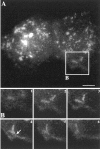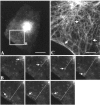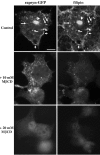Rapsyn escorts the nicotinic acetylcholine receptor along the exocytic pathway via association with lipid rafts
- PMID: 12388596
- PMCID: PMC6757681
- DOI: 10.1523/JNEUROSCI.22-20-08891.2002
Rapsyn escorts the nicotinic acetylcholine receptor along the exocytic pathway via association with lipid rafts
Abstract
The 43 kDa receptor-associated protein rapsyn is a myristoylated peripheral protein that plays a central role in nicotinic acetylcholine receptor (AChR) clustering at the neuromuscular junction. In a previous study, we demonstrated that rapsyn is specifically cotransported with AChR via post-Golgi vesicles targeted to the innervated surface of the Torpedo electrocyte (Marchand et al., 2000). In the present study, to further elucidate the mechanisms for sorting and assembly of postsynaptic proteins, we analyzed the dynamics of the intracellular trafficking of fluorescently labeled rapsyn in the transient-expressing COS-7 cell system. Our approach was based on fluorescence, time-lapse imaging, and immunoelectron microscopies, as well as biochemical analyses. We report that newly synthesized rapsyn associates with the trans-Golgi network compartment and traffics via vesiculotubular organelles toward the cell surface of COS-7 cells. The targeting of rapsyn organelles appeared to be mediated by a microtubule-dependent transport. Using cotransfection experiments of rapsyn and AChR, we observed that these two molecules codistribute within distal exocytic routes and at the plasma membrane. Triton X-100 extraction on ice and flotation gradient centrifugation demonstrated that rapsyn and AChR are recovered in low-density fractions enriched in two rafts markers: caveolin-1 and flotillin-1. We propose that sorting and targeting of these two companion molecules are mediated by association with cholesterol-sphingolipid-enriched raft microdomains. Collectively, these data highlight rapsyn as an itinerant vesicular protein that may play a dynamic role in the sorting and targeting of its companion receptor to the postsynaptic membrane. These data also raise the interesting hypothesis of the participation of the raft machinery in the targeting of signaling molecules to synaptic sites.
Figures









Similar articles
-
The myristoylated protein rapsyn is cotargeted with the nicotinic acetylcholine receptor to the postsynaptic membrane via the exocytic pathway.J Neurosci. 2000 Jan 15;20(2):521-8. doi: 10.1523/JNEUROSCI.20-02-00521.2000. J Neurosci. 2000. PMID: 10632581 Free PMC article.
-
Differential targeting of components of the dystrophin complex to the postsynaptic membrane.Eur J Neurosci. 2001 Jan;13(2):221-9. Eur J Neurosci. 2001. PMID: 11168526
-
Polarized sorting of nicotinic acetylcholine receptors to the postsynaptic membrane in Torpedo electrocyte.Eur J Neurosci. 1998 Mar;10(3):839-52. doi: 10.1046/j.1460-9568.1998.00091.x. Eur J Neurosci. 1998. PMID: 9753152
-
The postsynaptic submembrane machinery at the neuromuscular junction: requirement for rapsyn and the utrophin/dystrophin-associated complex.J Neurocytol. 2003 Jun-Sep;32(5-8):709-26. doi: 10.1023/B:NEUR.0000020619.24681.2b. J Neurocytol. 2003. PMID: 15034263 Review.
-
Targeted trafficking of neurotransmitter receptors to synaptic sites.Mol Neurobiol. 2002 Aug;26(1):117-35. doi: 10.1385/MN:26:1:117. Mol Neurobiol. 2002. PMID: 12392061 Review.
Cited by
-
Partition profile of the nicotinic acetylcholine receptor in lipid domains upon reconstitution.J Lipid Res. 2010 Sep;51(9):2629-41. doi: 10.1194/jlr.M005132. J Lipid Res. 2010. PMID: 20516251 Free PMC article.
-
MYRbase: analysis of genome-wide glycine myristoylation enlarges the functional spectrum of eukaryotic myristoylated proteins.Genome Biol. 2004;5(3):R21. doi: 10.1186/gb-2004-5-3-r21. Epub 2004 Feb 13. Genome Biol. 2004. PMID: 15003124 Free PMC article.
-
Delivery of the malaria virulence protein PfEMP1 to the erythrocyte surface requires cholesterol-rich domains.Eukaryot Cell. 2006 May;5(5):849-60. doi: 10.1128/EC.5.5.849-860.2006. Eukaryot Cell. 2006. PMID: 16682462 Free PMC article.
-
Dysregulation of Neuronal Nicotinic Acetylcholine Receptor-Cholesterol Crosstalk in Autism Spectrum Disorder.Front Mol Neurosci. 2021 Oct 11;14:744597. doi: 10.3389/fnmol.2021.744597. eCollection 2021. Front Mol Neurosci. 2021. PMID: 34803605 Free PMC article.
-
Fluorescence microscopy imaging of a neurotransmitter receptor and its cell membrane lipid milieu.Front Mol Biosci. 2022 Nov 28;9:1014659. doi: 10.3389/fmolb.2022.1014659. eCollection 2022. Front Mol Biosci. 2022. PMID: 36518846 Free PMC article. Review.
References
-
- Arni S, Keilbaugh SA, Ostermeyer AG, Brown DA. Association of GAP-43 with detergent-resistant membranes requires two palmitoylated cysteine residues. J Biol Chem. 1998;273:28478–28485. - PubMed
-
- Banting G, Ponnambalam S. TGN38 and its orthologues: roles in post-TGN vesicle formation and maintenance of TGN morphology. Biochim Biophys Acta. 1997;1355:209–217. - PubMed
-
- Barrantes FJ. The acetylcholine receptor ligand-gated channel as a molecular target of disease and therapeutic agents. Neurochem Res. 1997;22:391–400. - PubMed
-
- Bignami F, Camus G, Marchand S, Bailly L, Stetzkowski-Marden F, Cartaud J. Targeting of acetylcholine receptor and 43 kDa rapsyn to the postsynaptic membrane in Torpedo marmorata electrocyte. J Physiol (Paris) 1998;92:177–181. - PubMed
Publication types
MeSH terms
Substances
LinkOut - more resources
Full Text Sources
Molecular Biology Databases
